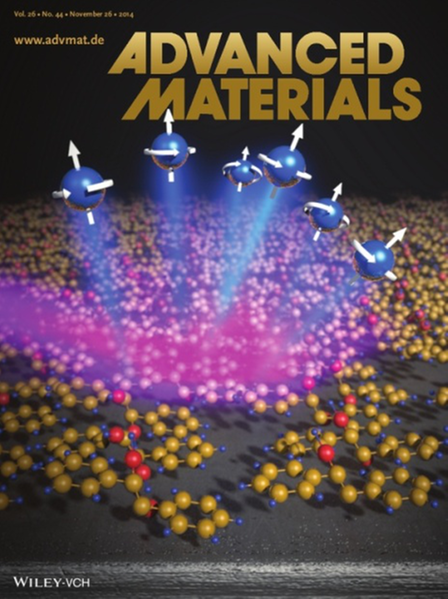Organic Spintronics

Organic Spintronics
Spintronic or spin electronic materials do exploit not only the electron charge but also the electron spin in electron transport applications. They allow to obtain increased functionalities and reduce energy consumption. Molecular or organic spintronics is aiming to exploit the flexibility offered by organic chemistry to obtain new spintronic materials and new applications. This is a field situated between organic chemistry and traditional spintronics. A new development in this area is the use of chiral molecular layers with which as we also have shown, it is possible to produce a new family of spin filter materials. Both long chiral molecular chains can be used as well as small chiral molecules for electron spin filtering purposes. We use, among others, core level spectroscopies for the characterization of organic spintronic materials. The study of core levels in organic compounds allows for the characterization of the electronic, magnetic and real space structure.
Development of new functional magnetic materials
This project uses core level spectroscopy and spectro-microscopy, to study the electronic and real space structure of low dimensional magnetic materials, useful in the context of spin electronics. Together with collaborators from the Universidad Autonoma de Madrid, the Institute for Advanced Studies of Madrid (IMDEA) Nanoscience, and the Institute of Physics of the Polish Academy of Sciences (IFPAN, Warsaw), we have studied at MAX IV-lab, self organized arrays of nanomagnets, ferromagnetic ultra-thin films and chiral molecules on surfaces. In the area of magnetic semiconductors we collaborate with the IFPAN (Warsaw, Poland), and the QSRC center (Seoul, Korea). We characterize the magnetism and electronic structure of magnetically doped ZnO and VO2 in an elemental and electron shell specific basis, focusing on the role of the spin orbit energy in stabilizing the magnetic response upon doping the semiconductor matrix. We use chiral molecule adsorption on ferromagnetic and non-ferromagnetic surfaces to link the induced electron spin polarization with the chiral symmetry.
Characterisation using x-rays at synchrotron radiation facilities
Part of the work is performed at synchrotron radiation laboratories, in particular at the MAX IV laboratory in Lund, Sweden. We study element specific magnetometry, using dichroism in the X-ray Absorption Spectroscopy (XAS) mode, or the reflected and scattered x-rays, after x-ray excitation. X-ray Photoemission Spectroscopy (XPS) and UV Spin Resolved Photoemission Spectroscopy are used if the systems under consideration allow for their application. We perform a spin polarization analysis of the emitted photoelectrons. X-ray Magnetic Circular and Linear Magnetic Dichroism (XMCD and XLMD), X-ray Resonant Magnetic Scattering (XRMS), Extended X-ray Absorption Fine Structure (EXAFS), Magnetic EXAFS (MEXAFS) are used, to probe the local crystallographic and magnetic structure. The high brilliance of the new SPECIES and VERITAS beamlines at MAX IV-lab serves as a strong motivation for this project to use Resonant Inelastic X-ray Scattering (RIXS) at MAX IV-lab, given the high energy resolution the new RIXS spectrometers do achieve at MAX IV-lab. Both the electronic structure and low energy excitations are investigated using RIXS.
Papers
Towards a new class of heavy ion doped magnetic semiconductors for room temperature applications,
Lee, N. G. Subramaniam, I.A. Kowalik et al. Scientific Reports 5, 17053 (2015)
Enantiospecific Spin Polarization of Electrons Photoemitted Through Layers of Homochiral Organic Molecules
Nino, I. Kowalik, F. Luque et al. Advanced Materials 26, 7474 (2014)

Contact
- Programme Professor Condensed Matter Physics of Energy Materials
- Håkan Rensmo
- Head of Division X-ray Photon Sciences
- Nicusor Timneanu
